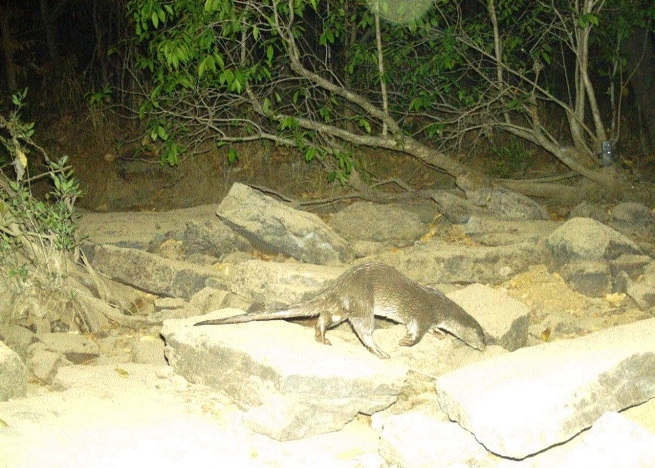Photographic evidence of Asian Small-Clawed Otter in C’garh
| Date :28-Oct-2020 |

Staff Reporter
RAIPUR,
In a landmark wildlife discovery, first photographic evidence of Asian Small-Clawed Otter or Panisuna (in local vernacular), (Aonyx Cinereus) has been reported from Udanti-Sitanadi Tiger Reserve of Chhattisgarh. There are 13 species of otters distributed worldwide and three species in India, but none of them were reported from Chhattisgarh until now. Otters belong to the mammalian order Carnivora and family Mustelidae. The three species of otters found in India are Eurasian Otter Lutra lutra, Smooth-coated Otter Lutrogale perspicillata, and Asian Small-clawed Otter Aonyx cinereus. Asian Small-Clawed Otter is the smallest of the three species and was till date known only from northern, southern, and eastern most parts of India and recently reported from Karlapat Wildlife Sanctuary and Kotagarh Wildlife Sanctuary, Odisha. In Chhattisgarh, the team of M Suraj, Moiz Ahmed & Faiz Bux from Nova Nature Welfare Society had set-up the camera traps which captured Otter.
This species inhabits perennial hilly streams of the riparian systems with big boulders and with or without a wide river bank. Asian or Oriental Small-clawed Otter is classified as Vulnerable as per IUCN Red List, protected under Schedule I of Wildlife (Protection) Act, 1972, and in Appendix I of Convention on International Trade in Endangered Species (CITES). Being an apex predator, otters play an important role in maintaining nutrition cycle between aquatic and terrestrial ecosystem. Degradation of forest, forest fires, and hunting activities spared a narrow domain for the wildlife to live and thrive. Due to political unrest, the rich biodiversity was highly-unexplored for many years. Multiple species are losing their existence or may also go locally extinct and unnoticed.
The water sources in the region are perennial with less biotic pressure. The researchers already had anecdotal records of otter presence in the area. The camera traps were deployed for tigers under All India Tiger Estimation in 2018. Six different photographic evidences of Asian Small-clawed Otter have been captured by two different camera trap units. Another set of evidences were collected 10km away region where Holts, Spraints, and tracks were identified across 1-km stretch of Shallow River. Nesting sites of these otters were identified from Spraints with lots of crab waste that justified it to be Asian Small-clawed Otter. As per the discussions with locals, identifying signs on trails across river streams from Kukrar beat and a total of six photo captures from Dadaipani beat of Kulhadighat range of USTR during camera trapping session suggests its distribution across the Kulhadighat range of the tiger reserve.
The scat samples observed during trails contained 80% to 90% undigested exoskeleton crab-waste and the length of its claw marks measured to be 43mm. Asian Small-clawed Otter signifies USTR’s prime importance and raises need of conservation efforts. This article shall also help other workers and policy maker in undertaking comprehensive steps for long term in-situ conservation of this species in Chhattisgarh. This opens a broad dimension in studying the ecology and status of Asian Small-clawed Otter in this pristine landscape central India.
Of the total 1,842km2 of the tiger reserve, the population of Asian Small-clawed Otter was confined to only Kulhadighat range. As discussed with the forest villagers there are no direct threats from the locals to these river streams, these otters use to bite and tear their nets. But it was clear that in response, no retaliation was raised by the locals. Similarly, the same site was being used by locals as well as these otters. During summers, the forest fires are another important matter of concern for the otters as well as their habitat. Further studies are solicited on complete status, distribution and threat assessments of this species in the Tiger Reserve and as well as in the state. Conservation of Asian Small-clawed Otter in such a challenging landscape needs skillful and arduous scientific studies along with conservation actions and awareness.